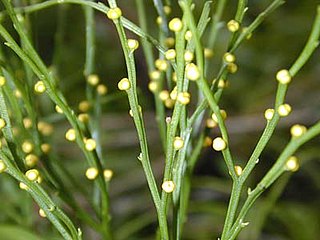
The ferns are a group of vascular plants that reproduce via spores and have neither seeds nor flowers. They differ from mosses by being vascular, i.e., having specialized tissues that conduct water and nutrients and in having life cycles in which the branched sporophyte is the dominant phase.
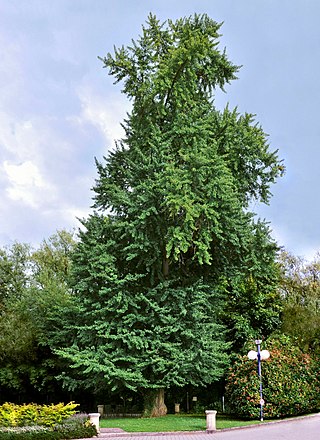
Ginkgo biloba, commonly known as ginkgo or gingko, also known as the maidenhair tree, is a species of gymnosperm tree native to East Asia. It is the last living species in the order Ginkgoales, which first appeared over 290 million years ago, and fossils very similar to the living species, belonging to the genus Ginkgo, extend back to the Middle Jurassic epoch approximately 170 million years ago. The tree was cultivated early in human history and remains commonly planted, and is widely regarded as a living fossil.

Psilotum is a genus of fern-like vascular plants. It is one of two genera in the family Psilotaceae commonly known as whisk ferns, the other being Tmesipteris. Plants in these two genera were once thought to be descended from the earliest surviving vascular plants, but more recent phylogenies place them as basal ferns, as a sister group to Ophioglossales. They lack true roots and leaves are very reduced, the stems being the organs containing photosynthetic and conducting tissue. There are only two species in Psilotum and a hybrid between the two. They differ from those in Tmesipteris in having stems with many branches and a synangium with three lobes rather than two.

Cycads are seed plants that typically have a stout and woody (ligneous) trunk with a crown of large, hard, stiff, evergreen and (usually) pinnate leaves. The species are dioecious, that is, individual plants of a species are either male or female. Cycads vary in size from having trunks only a few centimeters to several meters tall. They typically grow very slowly and live very long. Because of their superficial resemblance, they are sometimes mistaken for palms or ferns, but they are not closely related to either group.
In plant anatomy and evolution a microphyll is a type of plant leaf with one single, unbranched leaf vein. Plants with microphyll leaves occur early in the fossil record, and few such plants exist today. In the classical concept of a microphyll, the leaf vein emerges from the protostele without leaving a leaf gap. Leaf gaps are small areas above the node of some leaves where there is no vascular tissue, as it has all been diverted to the leaf. Megaphylls, in contrast, have multiple veins within the leaf and leaf gaps above them in the stem.
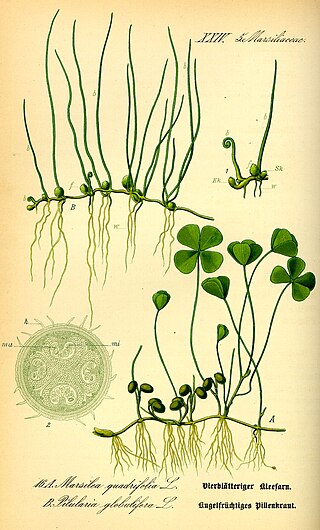
Marsileaceae is a small family of heterosporous aquatic and semi-aquatic ferns, though at first sight they do not physically resemble other ferns. The group is commonly known as the "pepperwort family" or as the "water-clover family" because the leaves of the genus Marsilea superficially resemble the leaves of a four-leaf clover. In all, the family contains 3 genera and 50 to 80 species with most of those belonging to Marsilea.
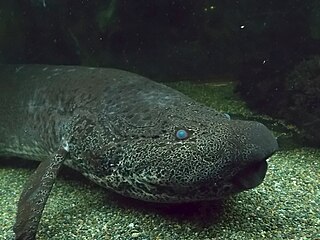
The marbled lungfish is a lungfish of the family Protopteridae. Also known as the leopard lungfish, it is found in Eastern and Central Africa, as well as the Nile region. At 133 billion base pairs, it has the largest known genome of any animal and one of the largest of any organism, along with the flowering plant Paris japonica, the fern Tmesipteris oblanceolata and the protist Polychaos dubium at 150 billion, 160 billion and 670 billion, respectively.

Psilotaceae is a family of ferns consisting of two genera, Psilotum and Tmesipteris with about a dozen species. It is the only family in the order Psilotales.

Nepenthes mollis, or the velvet pitcher-plant, is a tropical pitcher plant species natives to Kalimantan, Borneo. It used to be known only from a single dried herbarium specimen and is the sole recognised species in the genus Nepenthes of which the pitchers are unknown. In 2019 Global Wildlife Conservation announced the rediscovery of the species.

Equisetum arvense, the field horsetail or common horsetail, is an herbaceous perennial plant in the Equisetidae (horsetails) sub-class, native throughout the arctic and temperate regions of the Northern Hemisphere. It has separate sterile non-reproductive and fertile spore-bearing stems growing from a perennial underground rhizomatous stem system. The fertile stems are produced in early spring and are non-photosynthetic, while the green sterile stems start to grow after the fertile stems have wilted and persist through the summer until the first autumn frosts. It is sometimes confused with mare's tail, Hippuris vulgaris.

Tmesipteris, the hanging fork ferns, is a genus of ferns, one of two genera in the family Psilotaceae, order Psilotales . Tmesipteris is restricted to certain lands in the Southern Pacific, notably Australia, New Zealand and New Caledonia. In New Zealand this hanging epiphyte is common in the warm temperate rain forests of both main islands, where it can normally be found as short spiky dark-green fronds, often with lighter bag-like sporangia at the bases of some of its "leaves". The plant possesses no true leaves; what appear to be leaves are flattened stems. The fronds emerge directly from the fibrous root-mats which clad the trunks of mature tree ferns such as Dicksonia and Cyathea. Tmesipteris is from the Greek language, meaning a "cut fern", referring to the truncated leaf tips.

Ceratophyllum demersum, commonly known as hornwort, rigid hornwort, coontail, or coon's tail, is a species of flowering plant in the genus Ceratophyllum. It is a submerged, free-floating aquatic plant, with a cosmopolitan distribution, native to all continents except Antarctica. It is a harmful weed introduced in New Zealand. It is also a popular aquarium plant. Its genome has been sequenced to study angiosperm evolution.

A stem is on of two main structural axes of a vascular plant, the other being the root. It supports leaves, flowers and fruits, transports water and dissolved substances between the roots and the shoots in the xylem and phloem, photosynthesis takes place here, stores nutrients, and produces new living tissue. The stem can also be called halm or haulm or culms.

Diplazium australe, commonly known as the Austral lady fern, is a small fern occurring in eastern Australia, New Zealand and Norfolk Island. The habitat is moist shaded areas, often occurring in rainforest.

Paris japonica is a Japanese species of plants in the genus Paris in the family Melanthiaceae.

Adiantum viridimontanum, commonly known as Green Mountain maidenhair fern, is a fern found only in outcrops of serpentine rock in New England and Eastern Canada. The leaf blade is cut into finger-like segments, themselves once-divided, which are borne on the outer side of a curved, dark, glossy rachis. These finger-like segments are not individual leaves, but parts of a single compound leaf. The "fingers" may be drooping or erect, depending on whether the individual fern grows in shade or sunlight. Spores are borne under false indusia at the edge of the subdivisions of the leaf, a characteristic unique to the genus Adiantum.

Nepenthes robcantleyi, or Robert Cantley's pitcher plant, is a tropical pitcher plant endemic to the Philippine island of Mindanao. It is closely allied to N. truncata and was once considered a dark, highland form of this species. Nepenthes veitchii from Borneo is also thought to be a close relative.

Pilularia minuta is a species of fern in the family Marsileaceae. It is an ephemeral species that relies on seasonal flooding. Though widely distributed across the Mediterranean basin, it is considered an endangered species due to habitat fragmentation.
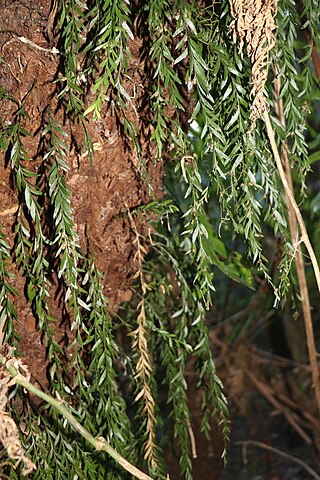
Tmesipteris obliqua, more commonly known as the long fork-fern or common fork-fern, is a weeping, epiphytic fern ally with narrow unbranched leafy stems. T. obliqua is a member of the genus Tmesipteris, commonly known as hanging fork-ferns. Tmesipteris is one of two genera in the order Psilotales, the other genus being Psilotum. T. obliqua is endemic to eastern Australia.
Tmesipteris horomaka, commonly known as the Banks Peninsula fork fern, is a fern ally endemic to New Zealand.
















